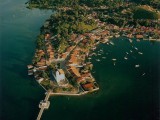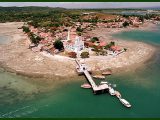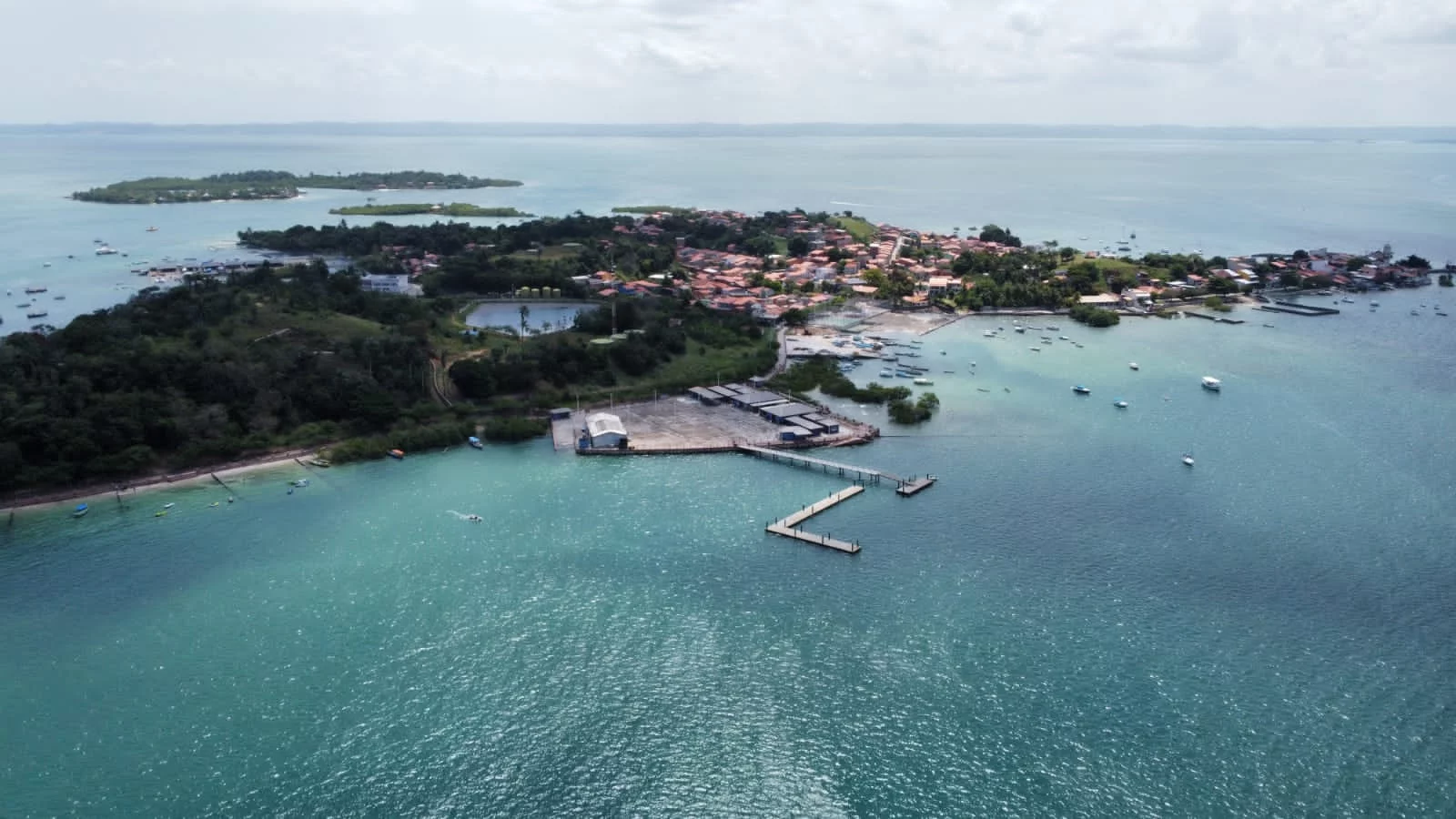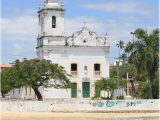Este post também está disponível em:
Português
English

Bom Jesus dos Passos Island in the Baia de Todos Santos is small and quiet, 10′ by boat from Madre de Deus, leaning against the island of Frades, has a sloop shipyard and only one village, with cobbled and tree-lined streets, bars, a simple restaurant and a bakery.
The Church of Bom Jesus dos Passos is the most prominent monument.
In the midst of mangroves and dense forest, between the islands of Madre de Deus and dos Frades, the island of Bom Jesus draws a beautiful scenery with the Church of Bom Jesus dos Passos in the background.
The sea, of a vast blue and calm waters, is ideal for fishing and water sports.
View the map of Baía de Todos os Santos
There are five thousand inhabitants in one kilometer of extension. Inns, restaurants and grocery stores, with great prices, a wide area for camping, water sports, fishing and four beaches of calm waters, of a beautiful blue, suitable for bathing.
They are: Pontinha beach, the beach in front of the church, Nordeste beach and Ponta do Padre beach.
The island also has a large area for camping.
Despite the almost ignorance of a large population of Salvador, the island of Bom Jesus dos Passos is part of Salvador.
Located between the islands of Frades and Madre de Deus, the only access to Bom Jesus dos Passos is by sea, through maritime vessels that depart from the municipality of Madre de Deus, which is 65 km from Salvador.
It is worth disembarking to walk in the quiet streets, where the population lives basically from fishing and carpentry.

It is interesting to visit the Duarte manor house, the fountains of Rua, Porrãozinho and Grande, and the Chapel of Nossa Senhora de Conceição.
It is precisely these characteristics that make Bom Jesus dos Passos a traditional fishing village, preserving cultural characteristics that present traces of both the Bahian recôncavo and the uniqueness of the popular Christian festivities that mark the island’s calendar.
“Hidden like a pearl in a shell with its fascinating natural beauty”, as Rita Freire describes it.
Videos about Bom Jesus dos Passos Island

Tourist information about Bom Jesus dos Passos Island
1. Tradition
The image of the secular houses, of simple architecture and loaded with history, is present on the island of Bom Jesus dos Passos
The fisherman and the rafts and sailboats, which characterize the traditional economic activity of the island, fishing. As it is in the villages of the Bahian recôncavo, in Bom Jesus dos Passos there are also the lace and shellfish ladies, who carry with them the gift and knowledge passed down for generations.
2. Religiosity
The outstanding cultural characteristic of Bom Jesus dos Passos is certainly its religiosity.
The main festivals on the island’s calendar are that of Senhor Bom Jesus dos Passos, in January, which is awaited through processions and novenas that precede it; and the maritime procession of Nossa Senhora dos Navegantes, which takes place the very next day, which is now celebrated on the second Saturday of January.
At this time the island receives visitors from all over the country, who do not bother to accommodate themselves in camping tents, since in the city there are only two modest inns.
3. Church of Bom Jesus dos Passos

The Church of Bom Jesus dos Passos is located on the island that bears its name, in the Bay of All Saints.
The church was granted a license in 1726 and its construction began in 1766. Its interior has neoclassical decoration, with three altars. The image of Senhor dos Passos was carved in wood by Félix Pereira. Its façade is in rococo style.
The church is under the care of the Brotherhood of Senhor Bom Jesus dos Passos, founded in 1815. The patron saint’s feast is in January.
Although the Church is in the municipality of Salvador, it is linked to the Parish of the Holy Family Jesus, Mary, Joseph, founded in 1661, in Madre de Deus, subordinate to the Diocese of Camaçari, dismembered from the Archdiocese of São Salvador, in 2010.
4. Illustrious figures
The best known, the singer and composer Gerônimo, was remembered for not abandoning his birthplace and for five years carrying out the project “O pagador de promessas”, which brings musical and cultural shows to the island.
No less important and illustrious for the inhabitants of Bom Jesus dos Passos is the artist Izolino Passos, who in addition to his renowned sculptures and oil paintings, was the creator of the traditional “Ternos de Reis”, the carnival blocks and the “caretas do carnaval”.
The “Ternos dos Reis” are ornate costumes for the carnival; the “caretas do carnaval” is the tradition, which began through the artist, in which children and young people wear masks and go out on the streets, in the days before the carnival, giving scares and having fun.
5. Beaches
The most popular beaches are Pontinha and Ponta do Padre, but unlike Ilha de Maré and Ilha dos Frades, there are no wide strips of sand.
6. History of Bom Jesus dos Passos Island
The island of Bom Jesus dos Passos was originally inhabited by Tupinambás Indians.
Its name was very different from what we know today – it was called Pataíba Assú, or Palmeira Pati wood. In 1624, it was colonized by the Dutch who, after a battle with the locals, settled on the island.
During this period, it was known as Ilha dos Brancos (White Island), because, according to the locals, blacks were not allowed to enter. “There was only one black man, known as Vorta-Sêca, a former slave,” says Ana Lessa;
The French also landed on the island of Bom Jesus dos Passos, and later came the first blacks from Maragojipe, a municipality that traded with the island.
For years, it served as a base for the sloops that transported goods from the recôncavo to Salvador.
“There were shipyards with master carpenters and sailmakers, making sails for the boats,” says Antonio Santos. The old-timers also say that the land on the island belonged to the Rosa Passos family, who donated it to the Brotherhood of Bom Jesus dos Passos, an entity that still exists today, and allotted the land.
It was in 1776 that the island of Bom Jesus dos Passos received its current name, when Dr. André de Carvalho built the church Nosso Senhor dos Passos, designed to be directed to the other islands in the region. It is affectionately called by the devotees and residents of princesinha.
The place where the church was built, in the past, served as a cemetery. During a renovation, several human bones were found. In the past, it was customary for nobles and bourgeois to be buried in churches.
The festival has Roman origins. It was the colonizers and Jesuits from the Iberian Peninsula who brought it to Brazil in the colonial period.
Its festivities, which mix religious precepts, are a celebration of the Christmas and Kings festivals, in the form of popular theater;
At that time, they used liturgical acts with the theme of the Three Kings, in the form of singing, dancing and staging, in the process of catechesis and teaching, both of the indigenous natives and of the Portuguese settlers themselves and, later, of the black slaves.
In Bahia, the first records of the festival date back to the early 18th century. At that time only the imperial elite took part.
The groups were made up of mostly women, who paraded adorned with props, carrying banners and wearing warm-colored costumes. They represented shepherdesses, ladies and gypsies. The men, meanwhile, paraded and played songs of religious origin in the band.
The celebration only began to become popular among the poorer classes in 1771 and reached its peak in the 30s.
Bahia.ws is the largest tourism and travel guide for Bahia and Salvador.




















